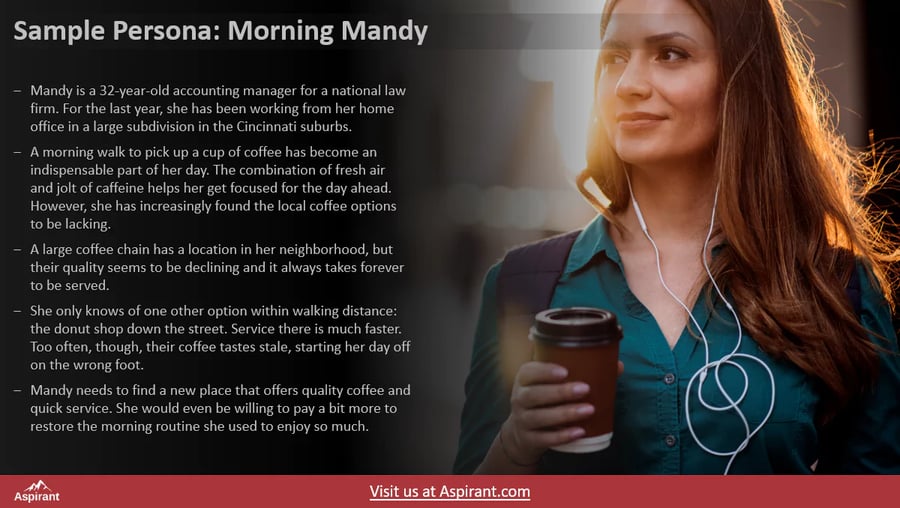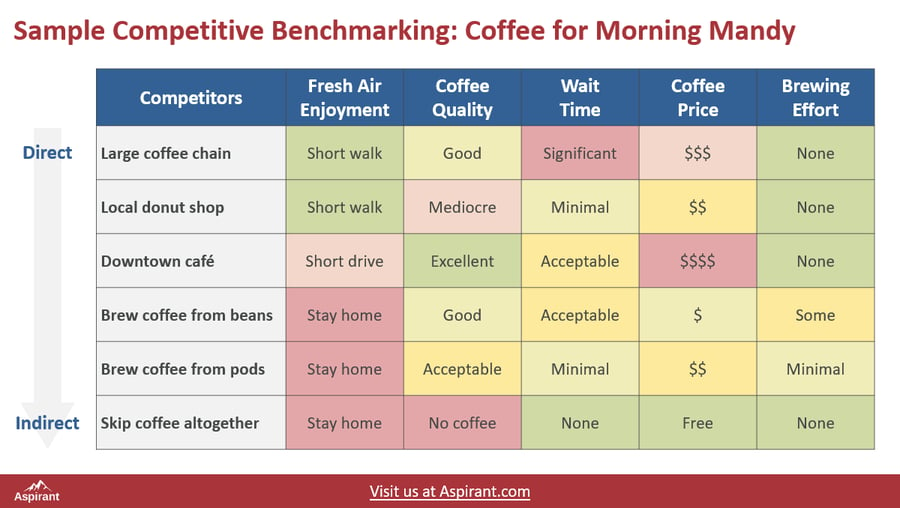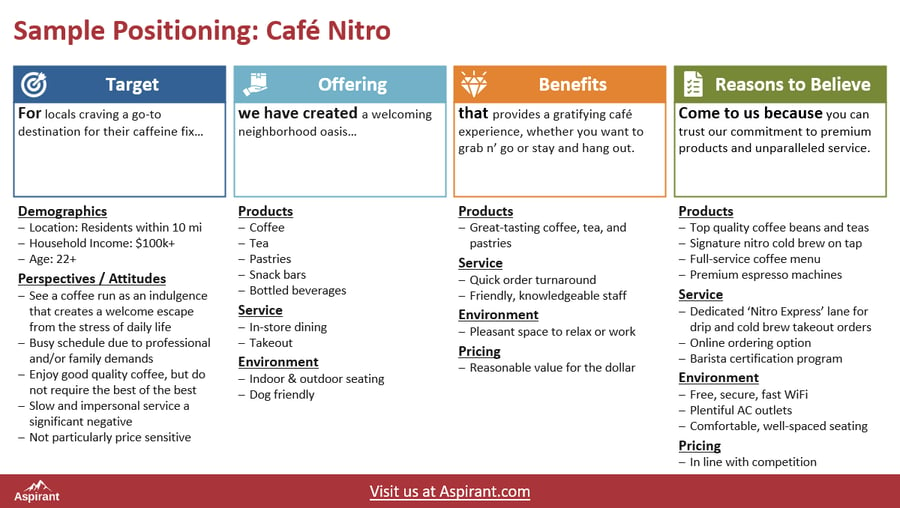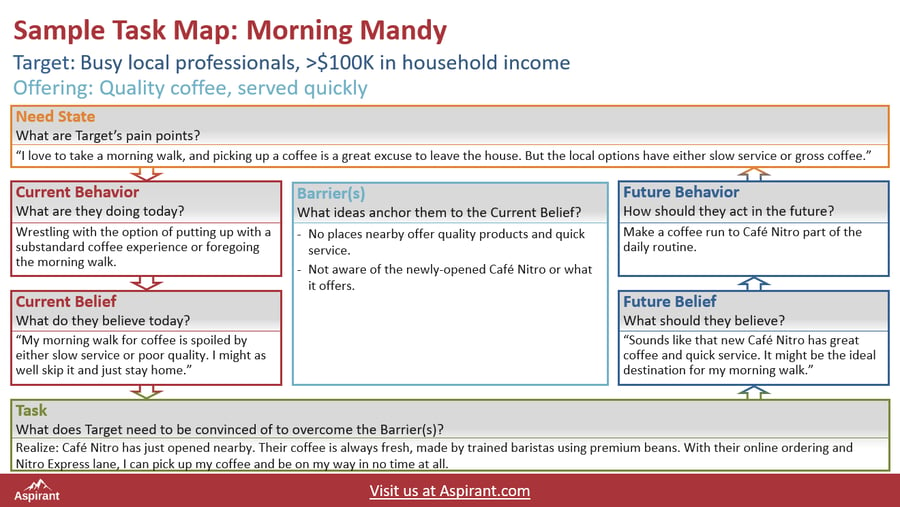by Aspirant Team
March 21, 2024
After building your organizational strategy, you will be ready to translate it into a marketing strategy. Here is our approach to create clarity that fuels more impactful differentiation and successful marketing campaigns.
The best fishermen don't throw a line in the water and just hope for the best. They go after a specific fish, know exactly what that fish loves to eat, and only hit the lake when those fish are hungriest. They even know when it's time to try another lake. Effective marketing campaigns require the same type of insight.
Thinking through the questions below will help ensure the features, positioning, and promotion of your product / service will resonate with your intended audience. Use the link at the bottom of this page to download templates and examples of the mentioned marketing strategy tools.
Along the way, we will provide simplified examples from the perspective of a boutique coffee shop, Café Nitro, to help illustrate the concepts at hand. These examples and the corresponding templates can be downloaded via the link at the bottom of the page.
It may be surprising, but marketing strategy should always begin with the end user - not what you are trying to promote. This anchors everything you do to their mindset. To analyze the psyche of each market segment, marketers often build a 'Persona'. A Persona is a profile for a fictional individual who represents a specific market segment. The appropriate number of Personas to develop will vary by the complexity of your offering and the variety of consumer perspectives.
Each Persona typically contains the following elements:
Personas make each segment much more relatable, simplifying the process of finding ways to create value for them, elevate their perception, and influence their decision making.

Sustainable business success is based on the ability to provide customers with more value than the competition. The details in your Personas will identify the primary drivers of 'value' for the corresponding market segment. The next step is to specify how your product / service will stand out from the competition by doing a better job of satisfying their needs.
You will need to consider how all relevant alternatives stack up against the target audience's needs and preferences. The competitive set and evaluation criteria will likely go beyond what is mentioned in the Persona.
As with most analytical methods, your benchmarking can be as basic or as complicated as you would like. Taking time to create a ranking algorithm based on weighted criteria and numeric scores would add nuance to clarify how competitors compare to one another. If available, include third party data like consumer ratings or reviews (Google, Yelp, Amazon, etc.) to account for the prevailing market perception - even if that perception is entirely off-base.

Knowing what your target wants and where the competition is missing the mark will point you directly toward how you can gain an advantage by addressing the unrecognized / unmet / underserved consumer need. Now it is time to compile the specifics of how you will create that competitive advantage. A piecewise approach helps guide that thinking:

Get inside your target's head. Break down the logic behind their decision making to identify what you need to tell them to change their mind, and in turn, change their actions. Building a Task Map for each Persona is very useful to that end:
This will clarify the talking points your targeted segment will find most compelling and convincing.

Building awareness with your end users is always positive. But to maximize the chance of converting visibility into revenue, you need to reach them in 'moments of truth'. These are situations before, during, and after their purchase that they consider what they will do, are doing, or have done. If you have the time, building a Customer Journey Map for your Personas would help determine these critical moments by thinking through how they are thinking, feeling, and acting at each step along the way. A multi-faceted campaign can then be constructed to align with each of those touchpoints.
For a streamlined approach, you can start with identifying when your target is most likely to need what your company offers. Highlighting the benefits of your product / service at the right time can create a very direct route to conversion.
Now it is time to put it all together: building a plan for reaching the right people with the right message at the right time. From the wide variety of marketing tactics available, it is critical to favor the ones that can do this job efficiently, and ideally during those 'moments of truth'.
The options fall into three categories, based on the medium by which your message is delivered:
This is comprised of static, offline channels such as:
Pros: These channels offer a method for reaching a broad audience where the goal is to build maintain awareness for an established product intended for everyone and there is not much need for target-specific messaging (McDonald's, Coca-Cola). They are set-and-forget; once deployed, they will run under the specified parameters without any oversight.
Cons: Pricing for these programs is based on the scale of their reach, making them inefficient for reaching audiences that are only a subset of the general population. Larger companies have access to volume discounts, compounding their advantage over smaller competitors with less to spend. Properly gauging performance in terms of impressions, engagement, conversion, or ROI is either difficult or simply impossible, minimizing the opportunity to learn from results. Being offline, they are inherently further removed from the action you are hoping to stimulate (check out your website, visit your store, buy your product).
Recommendation: Universally deprioritize Traditional Marketing until you are confident that there is no further upside from your Digital Marketing programs.
Digital Marketing is, of course, defined by the digital means that connect you with your target audience.
'Outbound' tactics reach out to serve your content to the targeted audience. Think of them as the dynamic, online versions of their Traditional counterparts:
Online research has become central to most of the decisions everyone makes day-to-day. By anticipating how your target will use the internet to find products / services / companies like yours and preparing accordingly, you can create consideration in this most critical 'moment of truth'. This is how 'Inbound' tactics generate incoming purchase interest in the form of site traffic, emails, phone calls, store visits, etc.
Pros: The ability to target people individually exponentially improves efficiency and effectiveness. Performance metrics for these tactics are detailed and readily available, enabling continual refinement and ROI calculation in real time. Where the success of Traditional campaigns depends on spending, Digital campaigns excel based on informed planning. That dynamic creates the opportunity to compete with, and prevail against, MUCH larger competitors.
Cons: Designing, deploying, and managing these programs properly requires a set of skills that can only be developed and honed through first-hand experience.
Recommendation: Businesses of any size, industry, and marketing budget should exclusively focus on fully optimizing their Digital Marketing programs (Inbound, then Outbound) before investing any time or money elsewhere. Partner with established Digital Marketing experts in order to flatten the learning curve for yourself and accelerate the realization of business results.
By 'Local' we are not referring to localized Traditional or Digital campaigns. Here, we are talking about self-organized activations in the immediate vicinity of your business. Creativity, elbow grease, and familiarity with the local community are needed in order to execute these programs well. Due to the minimal benefit relative to the time requirements, Local Marketing tactics typically don't make sense for large companies. But they can be an excellent way to forge a lasting emotional connection with the community.
Pros: Local Marketing initiatives often require more effort than dollars, which could equate to a very attractive ROI. Some could create an opportunity to make a sale on the spot. Face-to-face interaction with your target audience and partnerships with other area businesses can pay dividends for years to come.
Cons: The reach and corresponding upside is inherently limited. It is often difficult to find the time to devise and execute these programs. Risk that event-based tactics fall short of expectations due to inclement weather or other external circumstances.
Recommendation: Collaborate with colleagues and friends on building a list of Local Marketing ideas. Identify complementary businesses that might be interested in future cooperation. Keep an eye out for the opportunity to participate in programs or events that are already being planned and promoted. Once your Digital Marketing is well established, find low-risk ways to get your feet wet in Local Marketing.
Much like the preceding Strategic Planning Process, you may not have considered the marketing strategy concepts listed above. Hopefully the Café Nitro examples will help you utilize these frameworks in building an effective strategy for marketing your business. Click on the button below to download those examples and the blank templates, all in one file.
The next step will be to put that strategy into action. Click here to check out our suggestions for how companies behind the curve can jump start their Digital Marketing.
We are proud to have built a client base spanning Fortune100 corporations to local companies to non profit organizations - and everything in between. We apply the best practices from those programs along with our Integrated Expertise to support businesses of all shapes and sizes achieve their goals. Use the form below to request a free exploratory discussion about how we can do the same for your organization.